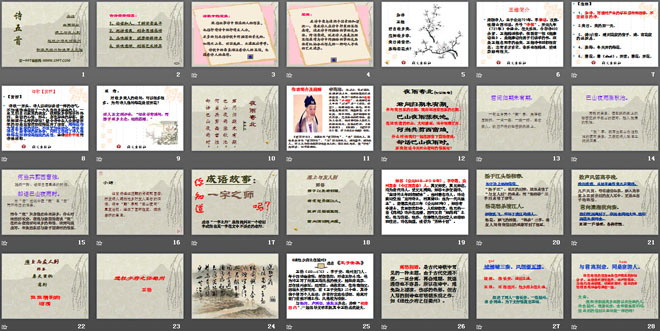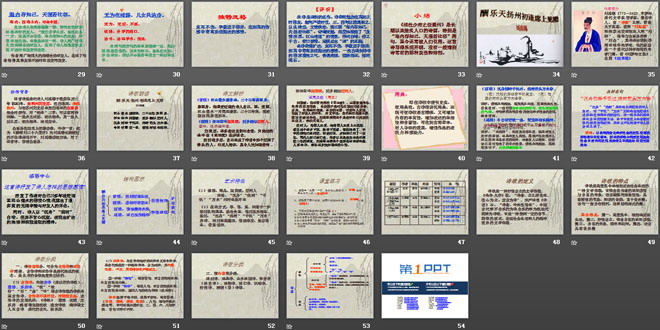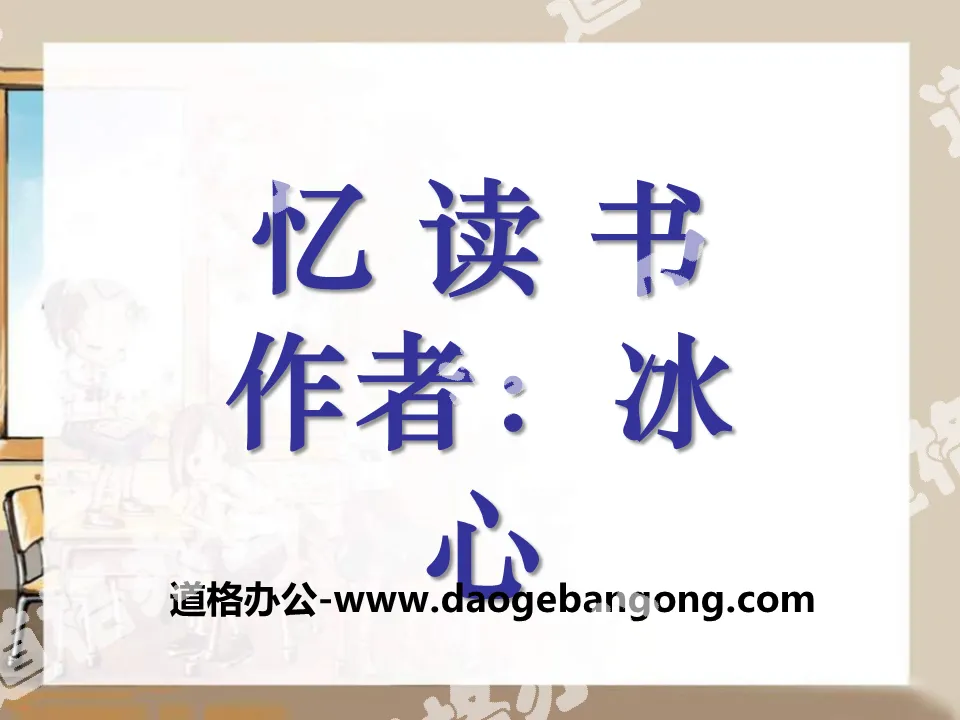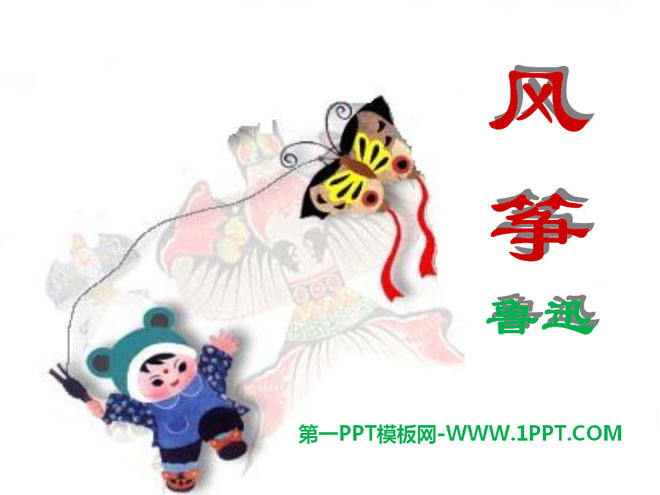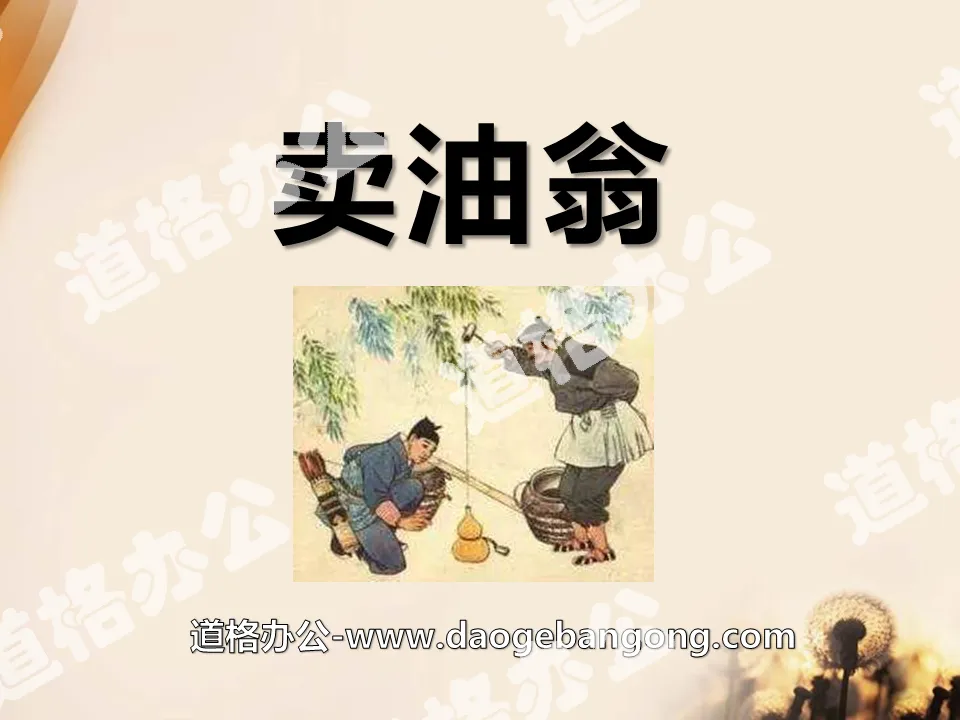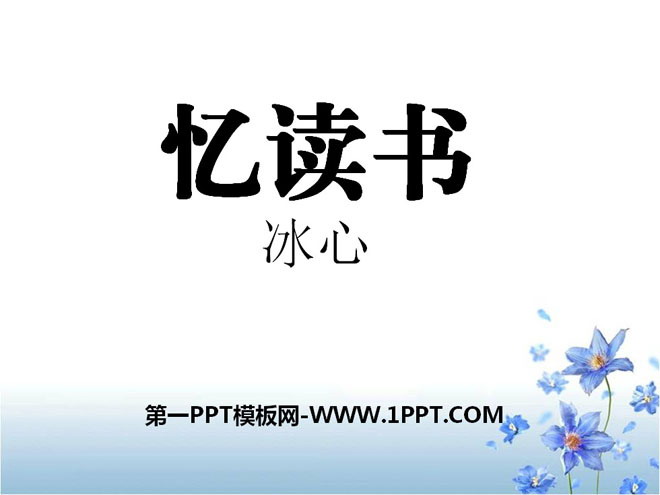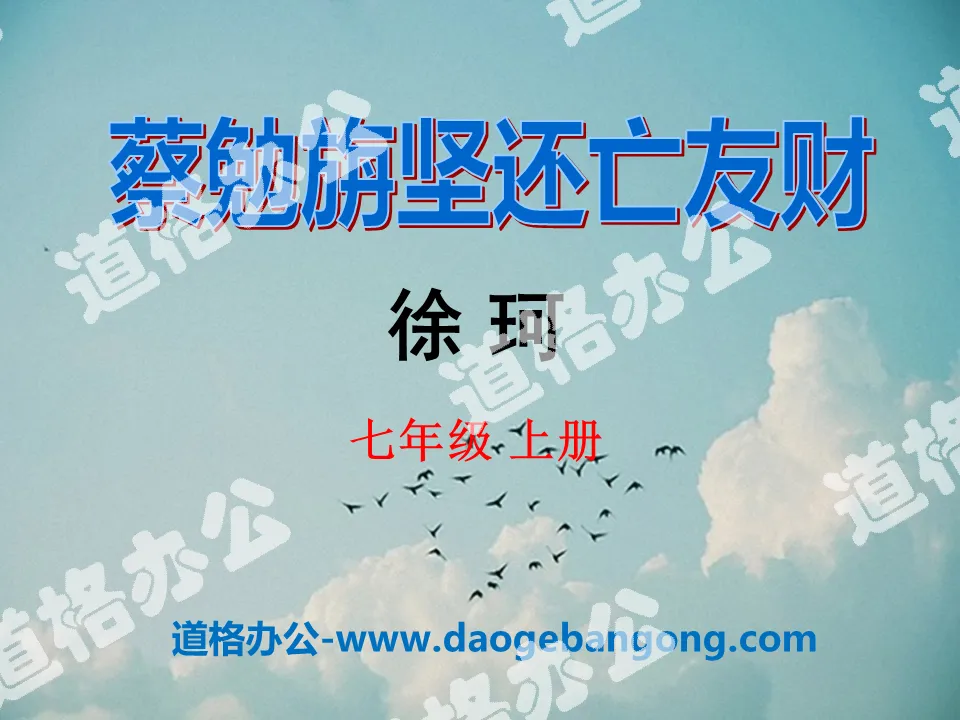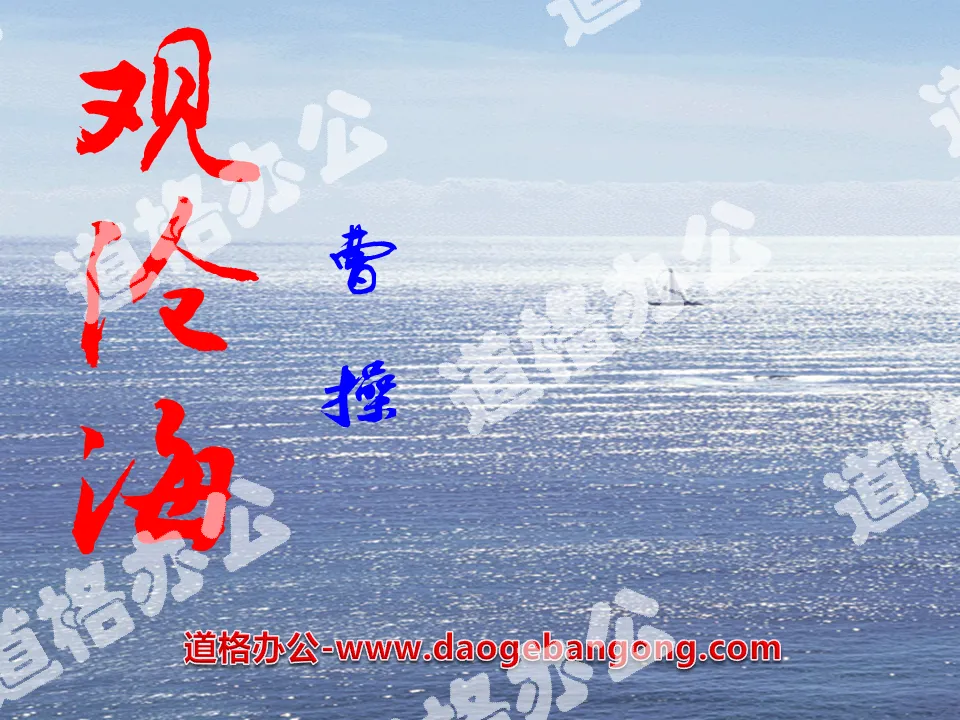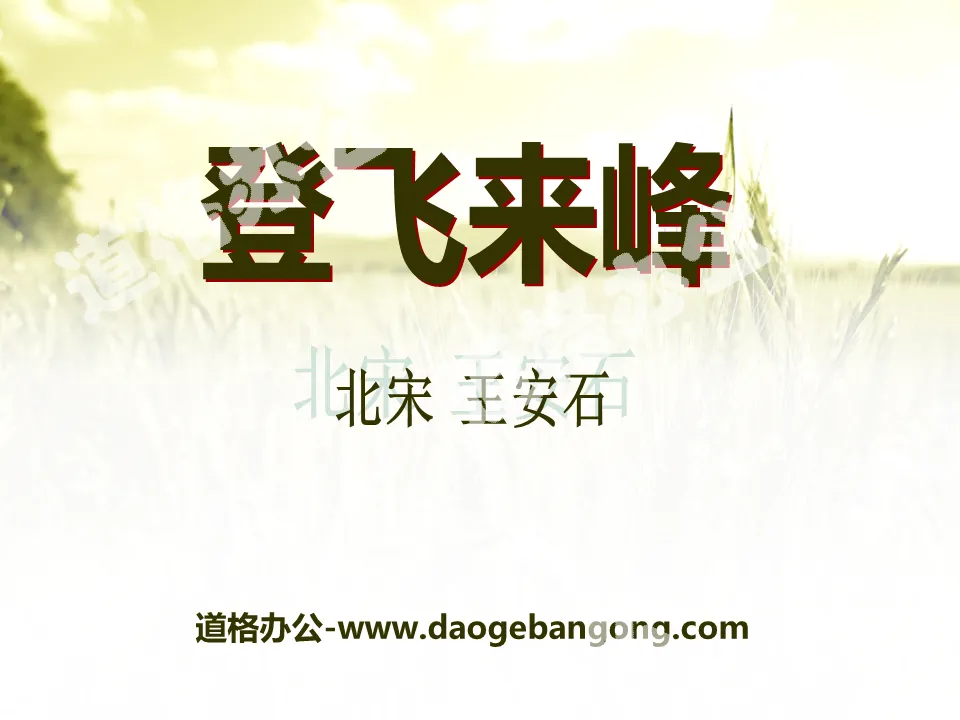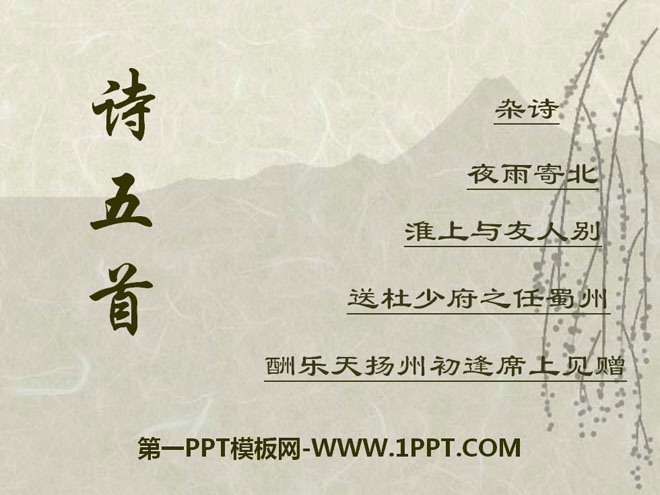
| Category | Format | Size |
|---|---|---|
| Chinese version seventh grade Chinese language volume 1 | pptx | 6 MB |
Description
"Five Poems" PPT courseware
Guidelines for appreciating ancient poetry:
1. Discuss the world and know people, understand the background and life
2. Grasp the image and understand the thoughts and feelings
3. Taste the language and figure out the rhetorical characteristics
4. Appreciate the artistic conception and understand the artistic realm
Imagery in poetry:
It refers not only to the characters created in narrative poems, but also to the lyrical protagonists in lyric poems, and more often to the scenery or objects described in poems.
Such as lakes and mountains, pastoral mulberry trees, lonely cities in the desert, etc.
The images in the poem pour into the poet's thoughts and contain the poet's feelings.
Artistic conception: It is the harmonious unity of the two elements of the poem, namely, the artistic conception and the artistic conception. Meaning is the thoughts and feelings expressed by the poet in the poem, and context is the things or pictures depicted in the poem. The so-called artistic conception is an intriguing artistic realm formed by the organic integration of the thoughts and feelings that the poet wants to express and the things or pictures depicted in the poem.
Introduction to Wang Wei
Tang Dynasty poet, born in 701 AD, named Mojie, Han nationality, ancestral home in Qi County, Shanxi Province, nicknamed "Poetry Buddha". In the ninth year of Kaiyuan (721), he became a Jinshi and was appointed Taile Cheng. There are more than 400 poems in existence today. Wang Wei is proficient in Buddhism. Buddhism has a "Vimalakirti Sutra", which is a book in which Vimalakīrti lectures to his disciples. This is the origin of Wang Wei's name. Wang Wei is famous for his poetry, calligraphy and painting, and is very versatile. Music is also very proficient. He is greatly influenced by Zen Buddhism.
【Note】
1. Miscellaneous poems: Write scattered thoughts and trivial matters that arise at any time, poems with no fixed title.
2. Lai Ri: The day of arrival.
3. Qi (qǐ) window: a window with carved patterns. Qi, patterned silk fabrics.
4. Winter plum: plum blossoms that bloom in winter.
5.花: zhuó, to open; to bloom, to bloom.
Night rain sent to the north
I asked you whether the return date has been announced.
The night rain in Bashan swells the autumn pond.
Why should we cut the western window candle together?
But it’s raining at night in Bashan.
Author introduction and solution
Li Shangyin, whose courtesy name was Yishan and whose name was Yuxisheng. Among the poets of the late Tang Dynasty, he had the highest artistic achievement in poetry. Together with another famous poet Du Mu, he was called "Little Li Du". He was also one of the "Three Lis" (Li Bai, Li He) among the poets of the Tang Dynasty. He is good at verses and quatrains. The poems he wrote are elegant and gorgeous, with vivid images. They are attentive to expressiveness and profound sustenance, and have a unique artistic style. In particular, his love poems are the most widely read, and he had a great influence on future generations of poets and lyricists. The main famous works include: "Deng Le You Yuan", "Untitled", "Night Rain Sends to the North", etc. There is also "Li Yishan Poetry Collection" handed down to the world.
"Night Rain Sends to the North", the title of the poem is also "Night Rain Sends to Nei", "Nei" refers to his wife. Nowadays, most of the books are written as "Yeyu Sends to the North", where "Bei" refers to people from the north, either as wives or friends. Some people think that the poem was written to friends in Chang'an; but it seems more accurate to interpret the content of the poem as "sent within".
I asked you whether the return date has been announced.
There are two words "Qi" in one sentence, which first pause and then turn, with a question and an answer, a rise and a fall, and the sorrow of missing relatives and being unable to return is vividly displayed on the page.
The night rain in Bashan swells the autumn pond.
Writing about the scene in front of me makes the sorrow that has already appeared on the paper intertwined with the night rain in Bashan and blending into the swollen autumn pond.
The word "rise" not only describes the night rain scene of Bashan water pouring into the autumn pond, but also expresses the poet's deep and long sorrow.
Why should we cut the western window candle together?
Suddenly, I imagined the time when we would meet again in the future.
But it’s raining at night in Bashan.
Tell "Jun" about the situation where "I" miss "Jun" tonight and cannot return.
Now "I" am alone in a remote foreign land. When will I return to Chang'an? I will cut candles with my wife at night and talk about "I"'s homesickness while listening to the rain at night in Bashan. These two sentences are fictitious, imagining the scene when you reunite with your wife after returning home.
Summary: This poem expresses the poet's deep affection for his friends while traveling in a foreign country through questions and answers about his return date. The word "Qi" and "Bashan Night Rain" appear repeatedly in the poem, creating a looping, lingering and tortuous meaning.
Farewell to friends on the Huai River
Willow spring at the head of the Yangtze River,
Yang Huachou killed the people crossing the river.
Several bagpipes left the pavilion late,
You go to Xiaoxiang and I go to Qin.
Zheng Gu (848-909 AD), courtesy name Shouyu, was born in Yichun, Yuanzhou (now Yichun, Jiangxi Province). His father Zheng Shi and his brother Zheng Qi were both poets in the Tang Dynasty. Influenced by his father and brother, Zheng Gu was able to write poems at the age of seven, and "he started to write poems and chants when he was riding bamboo." Sikong Tu, a famous poet and poetry critic at that time, "was surprised when he saw it. He picked it up and said: He should be the master of a generation of coquettish people." In the third year of Emperor Xizong's reign of Emperor Guangqi of the Tang Dynasty (AD 887), Zheng Gu passed the imperial examination and became a doctor in the imperial examination. He was known as Zheng Duguan. A poem he wrote called "Partridge" became famous far and wide, so he was also known as "Zheng Partridge". He often sang and interacted with nine of his contemporaries, including Xu Tang, Zhang Qiao, and Ren Tao. He was famous for his poems and was known as one of the "Ten Philosophers in Fanglin".
Artistic features
(1) Rhetoric: Allusions: Wen Di Fu, Lan Ke Ren
Metaphors: "sinking boat", "sick tree", "thousand sails" and "ten thousand trees" are also contrasts
(2) Expression method: If events, emotions, scenes, and theories are integrated into one, the situation will be bumpy and politically frustrated. Love brings sorrow and joy together. Scenery: "sinking boat", "sick tree", "thousands of sails" and "ten thousand trees" are mentioned simultaneously. The meaning of Logos is high and profound. Emotions arise from events, scenes arise from emotions, and scenes are used to reason.
Class exercises
1. The word "abandonment" in the first couplet contains the poet's infinite ( ) and also reveals his inner ( )
2. Two allusions are used in the chin couplet. These two allusions are ( ) and ( )
3. One of the following errors in the appreciation of the neck couplet is ( )
A Neck couplet looks forward to the future, with a magnificent image, showing a generous and high-spirited spirit.
B The poem uses changes in natural scenery to imply the development and changes of society, and contains philosophy.
C. The poet uses "sinking boat" and "sick tree" to describe himself in the poem, which makes him appear very pessimistic.
D The poet showed his broad-minded mind and enterprising spirit through the artistic image he created.
definition of poetry
Poetry is a literary genre that expresses emotions and aspirations. "Mao's Poems - Preface" contains: "Poetry is where ambition lies. The heart is ambition, and the speech is poetry." Song Yan Canglang's "Poetic Talk" says: "Poets sing about temperament." In ancient China, those who were not happy were called poems, and those who were happy were called songs. In modern times, they are collectively called poems. It is a literary genre that expresses social life and people's spiritual world according to certain syllable and rhythm requirements.
characteristics of poetry
Poetry is a literary genre that highly summarizes and reflects social life. It is full of the author's thoughts, feelings and rich imagination. The language is concise and vivid, has a distinctive rhythm, harmonious phonology, rich in musical beauty, and ordinary sentences. Arrange in separate rows, paying attention to the beauty of structural form.
Basic characteristics: first, it reflects life in a highly concentrated and general way; second, it expresses emotions lyrically and is full of rich thoughts and feelings; third, it is rich in imagination, association and fantasy; fourth, the language has musical beauty.
Poetry classification
1. Poetry can be divided into two categories: ancient style poetry and modern style poetry. Ancient style poetry and modern style poetry are concepts formed in the Tang Dynasty, and are divided from the perspective of the rhythm of poetry.
(1) Ancient poetry: including ancient poetry (poetry before the Tang Dynasty), Chu Ci, and Yuefu poetry. Poems in ancient poetry genres such as "song", "gexing", "yin", "qu" and "yin" also belong to ancient poetry. Ancient poetry does not focus on antithesis and rhymes more freely. The development trajectory of ancient poetry: "The Book of Songs" → Chu Ci → Han Fu → Han Yuefu → Wei, Jin, Southern and Northern Dynasties folk songs → Jian'an poetry → Tao Shi and other literati five-character poems → the ancient style and new Yuefu of the Tang Dynasty.
(2) Modern poetry: Modern poetry, which is opposite to ancient poetry, is also called modern poetry. It is a metrical poetry formed in the Tang Dynasty. It is divided into two types. There are strict regulations on the number of words, number of sentences, level and rhyme, etc.
① One type is called "quatrains", each of which has four sentences. The five-character poem is referred to as Wujue, and the seven-character poem is referred to as Qijue.
② One type is called "Lvshi", each poem has eight lines, five-character poems are referred to as Wulu, seven-character poems are referred to as Qilv, and those with more than eight sentences are called Pailu (or Long Rhythm).
Rhymed poetry originated in the Southern and Northern Dynasties and matured in the early Tang Dynasty. Each poem has four couplets (first couplet, chin couplet, neck couplet, and last couplet). Eight sentences, each sentence must have the same number of words, the two middle couplets must be opposite, the second, fourth, sixth and eighth sentences rhyme, and the first sentence may or may not rhyme.
2. Classification by content:
Farewell poems, frontier fortress poems, landscape and pastoral poems, nostalgic poems (epic poems), poems about objects, mourning poems, allegorical poems, travel poems, reward and reply poems, etc.
Keywords: Five Poems teaching courseware, Chinese version of seventh grade Chinese courseware for the first volume, seventh grade Chinese slide courseware download, Five Poems PPT courseware download, .ppt format
For more information about the "Five Poems" PPT courseware, please click the "Five Poems" ppt tab.
"Five Short Poems" PPT free courseware:
"Five Short Poems" PPT free courseware Part One: Learning Objectives 1. Read the poems accurately, rhythmically, and emotionally, and become recited by heart. 2. Read aloud repeatedly to appreciate the vividness of the poem's description and the profoundness of its meaning. 3. Try to figure out how the taste is concise, relevant and rich..
"Five Short Poems" PPT free download:
"Five Short Poems" PPT Free Download Part One Content: Poetry Analysis Moon Night by Shen Yin Moyi, introduction of new courses In January 1918, "New Youth" published nine vernacular poems for the first time, which was a catastrophe for Chinese new poetry; Shen Yin Mo's "Moon Night" Heran is one of them. must..
"Five Short Poems" PPT teaching courseware:
The first part of the PPT teaching courseware of "Five Short Poems": Accumulate common literary information before independent learning class and get to know the author Shen Yinmo (18831971), formerly known as Junmo, with the courtesy name, Qiu Ming, a native of Wuxing, Zhejiang (now Wuxing District, Huzhou), and a poet , calligrapher. His major works include "Autumn..."
File Info
Update Time: 2024-07-09
This template belongs to Chinese courseware Chinese version seventh grade Chinese language volume 1 industry PPT template
"Five Poems" PPT courseware Simple campus recruitment activity planning plan summary enterprise and institution recruitment publicity lecture PPT template is a general PPT template for business post competition provided by the manuscript PPT, simple campus recruitment activity planning plan summary enterprise and institution recruitment promotion Lecture PPT template, you can edit and modify the text and pictures in the source file by downloading the source file. If you want more exquisite business PPT templates, you can come to grid resource. Doug resource PPT, massive PPT template slide material download, we only make high-quality PPT templates!
Tips: If you open the template and feel that it is not suitable for all your needs, you can search for related content "Five Poems" PPT courseware is enough.
How to use the Windows system template
Directly decompress the file and use it with office or wps
How to use the Mac system template
Directly decompress the file and use it Office or wps can be used
Related reading
For more detailed PPT-related tutorials and font tutorials, you can view: Click to see
How to create a high-quality technological sense PPT? 4 ways to share the bottom of the box
Notice
Do not download in WeChat, Zhihu, QQ, built-in browsers, please use mobile browsers to download! If you are a mobile phone user, please download it on your computer!
1. The manuscript PPT is only for study and reference, please delete it 24 hours after downloading.
2. If the resource involves your legitimate rights and interests, delete it immediately.
3. Contact information: service@daogebangong.com
"Five Poems" PPT courseware, due to usage restrictions, it is only for personal study and reference use. For commercial use, please go to the relevant official website for authorization.
(Personal non-commercial use refers to the use of this font to complete the display of personal works, including but not limited to the design of personal papers, resumes, etc.)
Preview

